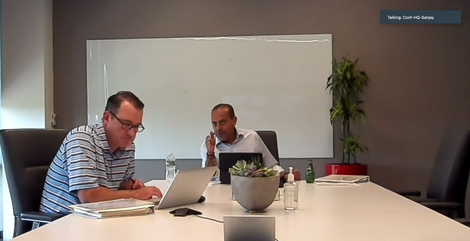“We’ve seen seen data management, data protection stay on top of customers’ agendas, as the people settled into this new world of working and cloud became top of mind,” says CommVault CEO Sanjay Mirchandani, center. At left, CFO Brian Carolan.
Storage technology stalwart Commvault Tuesday morning reported fiscal Q1 revenue and profit that both beat Wall Street’s expectations, but an outlook for revenue that was merely in line with consensus, and a word of caution that the timing of closing large software sales with enterprise customers could slip because of the pandemic.
The report sent CommVault shares down 8% in Tuesday trading.
Commvault’s CEO, Sanjay Mirchandani, and chief financial officer, Brian Carolan, chatted with ZDNet via Zoom following the results.
“We’ve seen seen data management, data protection stay on top of customers’ agendas, as the people settled into this new world of working and cloud became top of mind,” said Mirchandani.
In particular, Mirchandani said that the company is seeing new interest in “our little rising star,” as he refers to Metallic, CommVault’s cloud-based backup software product that debuted in October of 2019.
Metallic is taking on new significance as a solution to ransomware, leading to new customer engagements.
“In light of the increased velocity of Ransomware, and eyes on it, we have been having a lot of these conversations” about back up, said Mirchandani.
Metallic can, with the push of a button, send a copy of corporate data to an air-gapped server, so that if a company’s data is held captive via ransomware, the company can use Metallic to roll-back to a known good copy.
The “worst case scenario” is that malicious parties will eventually get inside of a corporate data center, said Mirchandani. “We do as much as we can below the covers for our customers,” he said, “giving them the sensors and telemetry to let them decide what they want to do” about such attacks.
But, if malicious parties do gain entry, “then we say, Let’s say this set of data is something I want available if the sky falls, and we need to have it clean and untouched.” Not all companies will cotton to backup as a solution for ransomware, said Mirchandani, if only because of complexity of how a company’s data has been amassed to date.
“If you’ve been in business five years, you’ve got a little of everything, you’ve got a little Oracle, you’ve a little Microsoft, you’ve got a little in the cloud, you’ve got a little on premise,” explained Mirchandani.
“That builds complexity, so you’ve got to really say, what is my policy, what are my crown jewels.” That complexity should be good for CommVault which “pride ourselves on solving hard problems” while relieving an already burdened IT to focus on other things, he said.
Over and above just ransomware, CommVault is finding new interest among small and medium-sized businesses. CommVault has traditionally been an enterprise vendor, but the company is partnering increasingly with managed service providers as a channel to reach those smaller companies.
“They’re all re-inventing how they engage, their business models,” said Mirchandani of small companies. “The pandemic forced that on people, they’re backed into a transformation strategy.” Such smaller companies wanting to do digital transformation have had to “fall back on partners,” having less in-house talent.
“I have a simplified way of looking at it,” he said. “The pandemic was a catalyst for folks looking at their digital strategies, their digital strategies availed the cloud, the cloud needs a whole new stack for doing it, and you have to lean in on the ecosystem to help you get there, because that’s just the way it is.”
Security violations such as ransomware have upped the ante for small businesses, he said. “It doesn’t matter whether you’re small or large, you’re still getting pounded.”
CommVault’s revenue in the three months ended in June rose 7%, year over year, to $183.4 million, yielding a net profit of 62 cents a share, excluding some costs.
Analysts had been modeling $182 million and 52 cents per share.
The quarter saw more progress as regards CommVault’s shift to selling more and more product on a recurring basis. Recurring revenue was 78% in the quarter, up from 76% in the quarter, and 74% the quarter before that. CommVault has said it expects to reach a point of having 80% to 85% of its revenue being recurring come 2023.
For the current quarter, Carolan told analysts during the company’s conference call that Wall Street’s consensus for $184.5 million this quarter “is reasonable.”
That counts as an “in-line” forecast for the company. The shares may be under some pressure from Carolan telling the Street that the timing of closing large enterprise deals cloud slip this quarter given ongoing uncertainty about the course of the pandemic.
“We’re just calling it out, we don’t know what we don’t know,” said Carolan.
“Mentioning the fact that the world is still suffering through a pandemic, I hope, is not news,” added Mirchandani.
Added Carolan, “We feel really good about the targets we laid out for fiscal ’23, we are right on track, and there might be some quarter variability, but nothing specific that we’re seeing.”
Asked if a merely in-line forecast is enough to satisfy investors, Carolan noted that the outlook should be taken in the context of CommVault having ceased its hardware operations in Q4. The company now is a pure software-only vendor.
That means that its results at present are somewhat distorted by being compared with sales in the prior-year periods that still contained revenue from the now-discontinued hardware products.
Backing out hardware sales the quarter-over-quarter growth outlook for this quarter is 20% “on a normalized basis,” Carolan pointed out to ZDNet.
“Calling 20% growth, in my mind, is pretty good,” said Mirchandani. “The other thing is, both Brian and I did reinforce that the guidance put out in January still holds, we’re right on course.”
